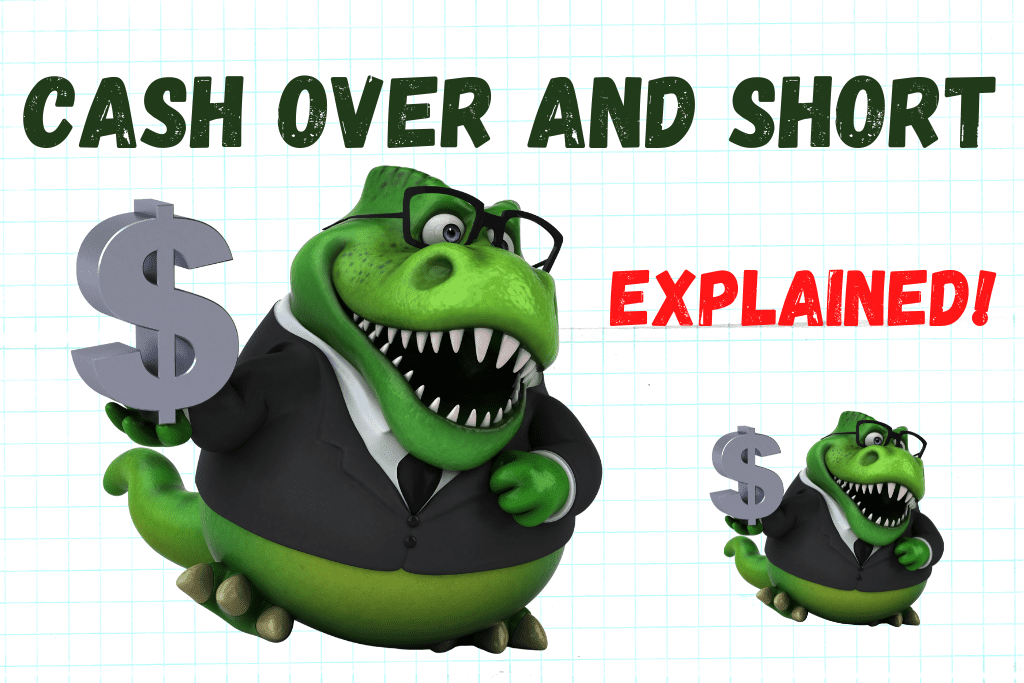Cash Over and Short is an income statement account used to track differences in cash collections from what is expected and what is actual. It is used in businesses that use cash in day-to-day operations, for example, retail stores and restaurants. Cash Over and Short reconciles what is in the cash drawer vs. what the cash register record says should be in the cash drawer.
Cash Over and Short acts like either a revenue account (cash over) or an expense account (cash short.) When too much cash is in the register compared to the register record, that cash becomes an “other revenue” amount. When too little cash is in the register compared to the register record, that shortage becomes an “other expense.”
Cash Over and Short account is also used for Petty Cash overages and shortages.
What is the Journal Entry to Record a Cash Overage?
When the cash in the register is more than the register record, the cash is accounted for as revenue. As an example, the cash register record indicates $125.05 is the amount of cash that should be in the register. A count of the actual cash shows the cash in the register is $126.05. The cash is over by $1.00. To record the overage, the following journal entry is done:
| Cash | 1.00 | |
| Cash Over and Short | 1.00 |
In this case, Cash Over and Short acts like a Revenue account.
What is the Journal Entry to Record a Cash Shortage?
When the cash in the register is less than the register record, the cash is accounted for as an expense. As an example, the cash register record indicates $125.05 is the amount of cash that should be in the register. A count of the actual cash shows the cash in the register is $124.05. The cash is short by $1.00. To record the shortage, the following journal entry is done:
| Cash Over and Short | 1.00 | |
| Cash | 1.00 |
In this case, Cash Over and Short acts like an Expense account.
What is the Journal Entry to Record Sales Total with a Cash Overage?
If a company is recording its full day of sales as a journal entry, and there is a cash overage, the amount can be included in the same journal entry. For example, the total cash sales for the day is $2,500. The register shows a $1.00 cash overage. The journal entry to record the transaction would be:
| Cash | 2,501 | |
| Cash Over and Short | 1 | |
| Sales | 2,500 |
Cash Over and Short acts as a Revenue account when there is an overage. Think of this as finding money on the ground. It’s “other revenue” for you, not a normal source of revenue like your paycheck.
What is the Journal Entry to Record Sales Total with a Cash Shortage?
If a company is recording its full day of sales as a journal entry, and there is a cash shortage, the amount can be included in the same journal entry. For example, the total cash sales for the day is $2,500. The register shows a $1.00 cash shortage. The journal entry to record the transaction would be:
| Cash | 2,499 | |
| Cash Over and Short | 1 | |
| Sales | 2,500 |
Cash Over and Short acts as an Expense account when there is an shortage. Think of this as losing money on the ground. It’s an “other expense” for you, not a normal expense like paying your bills.
Tracking Cash Over and Short is an important piece of protecting a company’s most valuable asset, Cash, from theft and misuse. It may seem like a small item to track, but think of it from the point of view of a retail or restaurant chain where millions of dollars pass through the cash registers every day. Every time a register is short, the company’s expenses increase and profits decrease. A series of cash overs and shorts may be a sign of theft or other problems in the company.
For more information and step-by-step guidance for completing accounting transactions for merchandising (retail) businesses, check out this Accounting Student Guide:

